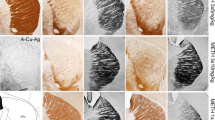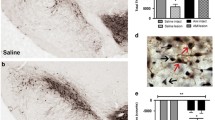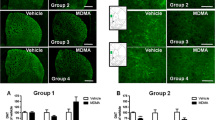Abstract
Neurturin (NTN) is a member of the glial cell line-derived neurotrophic factor (GDNF) family; and, while GDNF has been shown to increase dopamine (DA) release in normal animals, the ability of NTN to alter DA release has not been previously reported. The purpose of the present study was to determine if NTN could alter striatal DA release, and to compare the effects of NTN to GDNF. Male Fischer-344 rats were given a single injection of vehicle or 5 μg NTN or GDNF into the right substantia nigra. Three weeks later microdialysis experiments were conducted to assess striatal DA release. Basal extracellular levels of striatal DA were not affected by either NTN or GDNF. However, both NTN and GDNF led to increases in amphetamine-evoked overflow of DA from the ipsilateral striatum, and there was a trend for potassium-evoked overflow to be augmented. Postmortem tissue levels of DA were decreased by approximately 20% in the striatum, and increased by approximately 100% in the substantia nigra, on the ipsilateral side of the brain compared to the contralateral side following both NTN and GDNF injection. Thus, NTN, like GDNF, can augment striatal DA release, and the magnitude of the NTN effects are similar to those of GDNF.





Similar content being viewed by others

References
Hudson J, Granholm A-C, Gerhardt GA et al (1995) Glial cell line-derived neurotrophic factor augments midbrain dopaminergic circuits in vivo. Brain Res Bull 36:425–432
Martin D, Miller G, Cullen T et al (1996) Intranigral or intrastriatal injections of GDNF: effects on monoamine levels and behavior in rats. Eur J Pharmacol 317:247–256
Hebert MA, Van Horne CG, Hoffer BJ et al (1996) Functional effects of GDNF in normal rat striatum: presynaptic studies using in vivo electrochemistry and microdialysis. J Pharmacol Exp Ther 279:1181–1190
Xu K, Dluzen DE (2000) The effect of GDNF on nigrostriatal dopaminergic function in response to a two-pulse K+ stimulation. Exp Neurol 166:450–457
Rosenblad C, Georgievska B, Kirik D (2003) Long-term striatal overexpression of GDNF selectively downregulates tyrosine hydroxylase in the intact nigrostriatal dopamine system. Eur J Neurosci 17:260–270
Salvatore MF, Zhang J-L, Large DM et al (2004) Striatal GDNF administration increases tyrosine hydroxylase phosphorylation in the rat striatum and substantia nigra. J Neurochem 90:245–254
Kobayashi S, Ogren SO, Hoffer BJ et al (1998) Dopamine D1 and D2 receptor-mediated acute and long-lasting behavioral effects of glial cell line-derived neurotrophic factor administered into the striatum. Exp Neurol 154:302–314
Emerich DF, Plone M, Francis J et al (1996) Alleviation of behavioral deficits in aged rodents following implantation of encapsulated GDNF-producing fibroblasts. Brain Res 736:99–110
Hebert MA, Gerhardt GA (1997) Behavioral and neurochemical effects of intranigral administration of glial cell line-derived neurotrophic factor on aged Fischer 344 rats. J Pharmacol Exp Ther 282:760–768
Lapchak PA, Miller PJ, Jiao S (1997) Glial cell line-derived neurotrophic factor induces the dopaminergic and cholinergic phenotype and increases locomotor activity in aged Fischer 344 rats. Neuroscience 77:745–752
Grondin R, Cass WA, Zhang Z et al (2003) Glial cell line-derived neurotrophic factor increases stimulus-evoked dopamine release and motor speed in aged rhesus monkeys. J Neurosci 23:1974–1980
Kotzbauer PT, Lampe PA, Heuckeroth RO et al (1996) Neurturin, a relative of glial-cell-line-derived neurotrophic factor. Nature 384:467–470
Horger BA, Nishimura MC, Armanini MP et al (1998) Neurturin exerts potent actions on survival and function of midbrain dopaminergic neurons. J Neurosci 18:4929–4937
Akerud P, Alberch J, Eketjall S et al (1999) Differential effects of glial cell line-derived neurotrophic factor and neurturin on developing and adult substantia nigra dopaminergic neurons. J Neurochem 73:70–78
Zihlmann KB, Ducray AD, Schaller B et al (2005) The GDNF family members neurturin, artemin and persephin promote the morphological differentiation of cultured ventral mesencephalic dopaminergic neurons. Brain Res Bull 68:42–53
Hoane MR, Gulwadi AG, Morrison S et al (1999) Differential in vivo effects of neurturin and glial cell-line-derived neurotrophic factor. Exp Neurol 160:235–243
Hamilton JF, Morrison PF, Chen MY et al (2001) Heparin coinfusion during convection-enhanced delivery (CED) increases the distribution of the glial-derived neurotrophic factor (GDNF) ligand family in rat striatum and enhances the pharmacological activity of neurturin. Exp Neurol 168:155–161
Moghaddam B, Bunney BS (1989) Ionic composition of microdialysis perfusing solution alters the pharmacological responsiveness and basal outflow of striatal dopamine. J Neurochem 53:652–654
Cass WA, Harned ME, Peters LE et al (2003) HIV-1 protein tat potentiation of methamphetamine-induced decreases in evoked overflow of dopamine in the striatum of the rat. Brain Res 984:133–142
Glick SD, Dong N, Keller RW Jr et al (1994) Estimating extracellular concentrations of dopamine and 3, 4-dihydroxyphenylacetic acid in nucleus accumbens and striatum using microdialysis: relationships between in vitro and in vivo recoveries. J Neurochem 62:2017–2021
Cass WA, Manning MW (1999) GDNF protection against 6-OHDA-induced reductions in potassium-evoked overflow of striatal dopamine. J Neurosci 19:1416–1423
Pothos EN, Davila V, Sulzer D (1998) Presynaptic recording of quanta from midbrain dopamine neurons and modulation of the quantal size. J Neurosci 18:4106–4118
Eisenhofer G, Kopin IJ, Goldstein DS (2004) Catecholamine metabolism: a contemporary view with implications for physiology and medicine. Pharmacol Rev 56:331–349
Wood PL, Alter CA (1988) Dopamine release in vivo from nigrostriatal, mesolimbic, and mesocortical neurons: utility of 3-methoxytyramine measurements. Pharmacol Rev 40:163–187
Zetterstrom T, Sharp T, Collin AK et al (1988) In vivo measurement of extracellular dopamine and DOPAC in rat striatum after various dopamine-releasing drugs; implications for the origin of extracellular DOPAC. Eur J Pharmacol 148:327–334
Salvatore MF, Gerhardt GA, Dayton RD et al (2009) Bilateral effects of unilateral GDNF administration on dopamine- and GABA-regulating proteins in the rat nigrostriatal system. Exp Neurol 219:197–207
Robertson GS, Robertson HA (1989) Evidence that L-dopa-induced rotational behavior is dependent on both striatal and nigral mechanisms. J Neurosci 9:3326–3331
Trevitt JT, Carlson BB, Nowend K et al (2001) Substantia nigra pars reticulata is a highly potent site of action for the behavioral effects of the D1 antagonist SCH 23390 in the rat. Psychopharmacology 156:32–41
Gerhardt GA, Cass WA, Yi A et al (2002) Changes in somatodendritic but not terminal dopamine regulation in aged rhesus monkeys. J Neurochem 80:168–177
Hoffman AF, Van Horne CG, Eken S et al (1997) In vivo microdialysis studies of somatodendritic dopamine release in the rat substantia nigra: effects of unilateral 6-OHDA lesions and GDNF. Exp Neurol 147:130–147
Baloh RH, Enomoto H, Johnson EM Jr et al (2000) The GDNF family ligands and receptors–implications for neural development. Curr Opin Neurobiol 10:103–110
Airaksinen MS, Saarma M (2002) The GDNF family: signaling, biological functions and therapeutic value. Nat Rev Neurosci 3:383–394
Widenfalk J, Nosrat C, Tomac A et al (1997) Neurturin and glial cell line-derived neurotrophic factor receptor-ß (GDNFR-ß), novel proteins related to GDNF and GDNFR-α with specific cellular patters of expression suggesting roles in the developing and adult nervous system and in peripheral organs. J Neurosci 17:8506–8519
Golden JP, Baloh RH, Kotzbauer PT et al (1998) Expression of neurturin, GDNF, and their receptors in the adult mouse CNS. J Comp Neurol 398:139–150
Burazin TCD, Gundlach AL (1999) Localization of GDNF/neurturin receptor (c-ret, GFRα-1 and α-2) mRNAs in postnatal rat brain: differential regional and temporal expression in hippocampus, cortex and cerebellum. Mol Brain Res 73:151–171
Kozlowski DA, Miljan EA, Bremer EG et al (2004) Quantitative analysis of GFRα-1 and GFRα-2 mRNAs and tyrosine hydroxylase protein in the nigrostriatal system reveal bilateral compensatory changes following unilateral 6-OHDA lesions in the rat. Brain Res 1016:170–181
Rosenblad C, Kirik D, Devaux B et al (1999) Protection and regeneration of nigral dopaminergic neurons by neurturin or GDNF in a partial lesion model of Parkinson’s disease after administration into the striatum or the lateral ventricle. Eur J Neurosci 11:1554–1566
Acknowledgments
This study was supported in part by United States Public Health Service Grant AG17963.
Author information
Authors and Affiliations
Corresponding author
Rights and permissions
About this article
Cite this article
Cass, W.A., Peters, L.E. Neurturin Effects on Nigrostriatal Dopamine Release and Content: Comparison with GDNF. Neurochem Res 35, 727–734 (2010). https://doi.org/10.1007/s11064-010-0128-0
Accepted:
Published:
Issue Date:
DOI: https://doi.org/10.1007/s11064-010-0128-0



